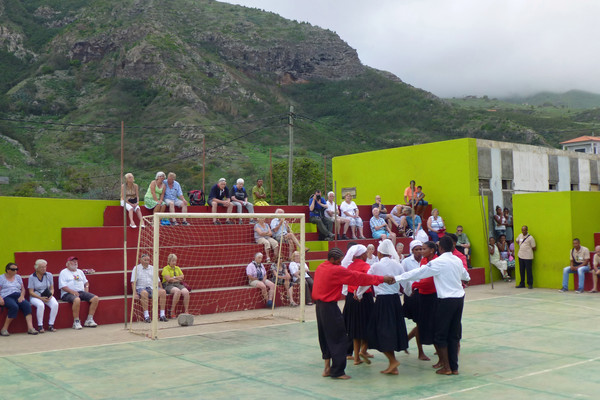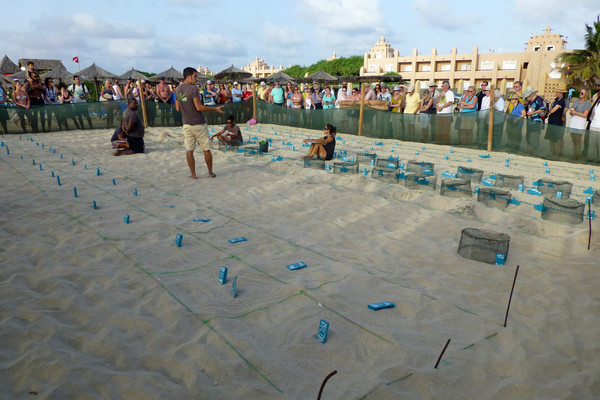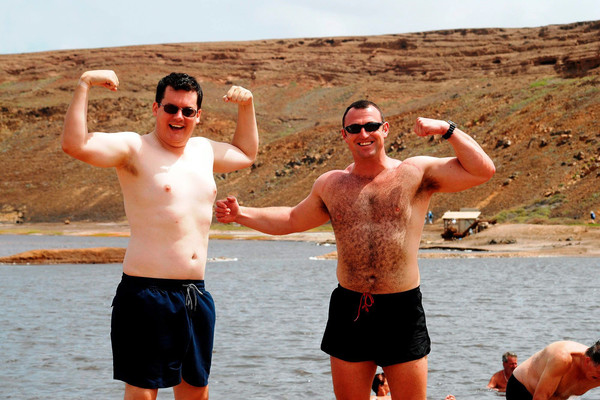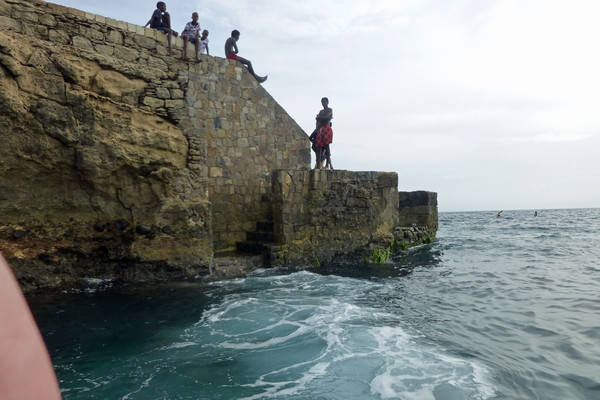Continuing our Voyage around Cape Verde
Good evening everyone! I have a slight confession on this occasion. It is only the evening of Saturday 3rd October as I write to you. This blog won’t be published until Friday 9th October, but I have been granted some holiday from my delivering and am going to be heading off on Monday, so I wanted to try and complete the Cape Verde story before I go away. As to where I will be headed? Well… as a seasoned Cruise Director who has been to a few countries. Actually, I’ll stop there. I like these blogs to have accurate information so I’m going to look up the exact answer to that question. Bear with me a moment. Gosh, I never realised the size of the can of worms that is opened when you try to define a “country”. The best I can come up with is via the UN website, which states that they have 193 member states, along with two observer states (Holy See and Palestine), and eleven other states. I will play it safe and stick with the 193 member states. Using more fingers and toes than I can manage, it turns out that I have been fortunate enough to visit 124 of the UN’s 193 member states. It has taken me 19 years ‘at sea’ to get that far, but clearly I still have a long way to go. So, of all those countries, where will I be headed next week? Well, if the lockdown regulations do not change between now and a few days’ time, I will be headed to the west coast of Wales. Gwynedd is one of the few counties to not have any local lockdown (as I type), and I’ve negotiated that everywhere I have booked to stay will be pay-on-arrival, just in case the situation changes. Fingers crossed it all works out well.
Meanwhile, since I last wrote… On 1st October, after a few months of campaigning, I was finally granted an official pair of shorts to wear on my delivery round. It might well have been a chilly day, with occasional showers, but I was determined. It reminded me of when Sir Laurence Olivier fought to restore the serving of kippers on the Brighton Belle in 1972. With cameras rolling to record the kippers’ triumphant return, Olivier delightfully announced: “I think we’ll have scrambled eggs this morning.” Those of you who have sailed with me will know that I think it is always shorts weather, wherever we are sailing, and so it was that I made a point of wearing them on 1st October – in spite of thinking that trousers were a much better idea! Yesterday, 2nd October, was a day-off which I spent going through a mountain of administration that I had carefully been avoiding. Today and tomorrow I am volunteering on the railway before I head off on my travels on Monday morning. After yesterday’s consistent rain, today has been a delightful sunny day down at Dungeness. “Green Goddess” was working the 2.36pm departure for Hythe and, if you didn’t know the scale, could easily have been mistaken for “Flying Scotsman” in her Apple Green LNER livery.

| Green Goddess” basks in the sun at Dungeness, ready for the 13½ mile run to Hythe |
Last week I wrote about Cape Verde and only completed the islands of São Vicente and São Nicolau. I promised I would continue our voyage around this fascinating archipelago, so here goes…
I remember arriving in Santo Antão very distinctly. The reason is that the fishermen were coming into port having been out at sea most of the night, but having to be careful to avoid the local children who were leaping off the quayside into the sea, and then climbing out and repeating the jump over and over again. I was thinking how wonderful it was that they weren’t stuck in front of computer screens or mobile phones and were doing something active and, judging by the noise they were making, thoroughly enjoying themselves.

| Children create a splash as they launch themselves off the quayside adjacent to our berth |
We boarded our mini-vans and headed up into the hills, with the now familiar rumble of the cobbled roads as the gentle soundtrack to our day. The barren, dry lands surrounding the town where we had berthed gave way to dark green vegetation, and we made a few stops at various viewpoints to look out over the valleys.

| Looking out over the valleys that dominate the volcanic islands of Cape Verde |
Eventually we arrived in the main square of the hilltop town. Not surprisingly, many of the islands had their principal towns up in the hills, so that they were safe from marauding pirates. Nowadays, the coastal towns which house the ports have become larger as the threat from piracy has disappeared, but it has left a legacy of interesting colonial architecture up in the shelter of the hills. No doubt, the cooler weather high up in the hills also played a part in the location of these towns. We arrived in the main square, with the cobblestones creating a beautiful pattern, and found that bunting had been displayed to welcome us. Little touches like that mean so much.

| The Main Square, beautifully decorated to celebrate our visit |
We entered the church and were grateful for the chance to take a pew and relax whilst the guide told us more about the town and its history. I stood at the back whilst the guide explained the way of life on the island, and found myself admiring the simple stained glass window. One of the things I’ve realised in my time visiting all these places, is that there is just as much beauty in the simple things as can be found in the more intricate displays.

| The sun lightening a stained glass window in the church in the main square |
After our visit to the old town, we were treated to a buffet lunch which included a large spread of the excellent traditional fayre. A local band were on hand to provide live entertainment – another wonderful little extra that I didn’t expect. We toured the nearby old school, which led to the amusing sight of all the passengers sat behind wooden desks whilst the guide held court. Everyone was very well behaved. On our way back to the ship we paused at a concrete five-a-side football pitch. Some youngsters were knocking a ball about and, whilst the passengers had a comfort stop, I motioned towards them to see if they’d let me join in. Music and sport really are a universal language. My knowledge of Portuguese is even worse than Colin Firth’s character in “Love Actually”, but when someone rolls a football towards you, everyone is speaking the same language. The hero of Cape Verde at the time of the cruise was a footballer called Nani, who was then playing for Manchester United. Although he played for the Portugal national team, his parents were both from Cape Verde, and he was therefore considered to be one of their own. I scored a goal and called out Nani’s name as I wheeled away in celebration, and then turned round to see the local boys in hysterics at the sight of this ungainly Englishman. One of them pointed towards me and said, “Peter Crouch”, and I realised that I had bitten off more than I could chew! They decided I should go in goal and we were having fun with them taking penalties against me. For the umpteenth time I turned round to fish the ball out of the net, and saw all the passengers were now sat on the benches around the pitch. The guide told me that it was now time for another show and he thanked the children as they cleared the pitch. Four couples then came into the centre of the pitch and, with musical accompaniment, performed some local cultural courtship dances. It was a very pleasant final stop before the drive back to the ship.

| The passengers sitting on the terracing to enjoy the Local Show |
The next island we visited could not have offered more of a contrast. The island of Sal is the main international tourist destination of Cape Verde, and yet it bears little resemblance to the other islands. It is mostly flat, with just the single peak in the middle, and very arid and sandy. Barely anything grows there, and without the desalination plants, I doubt there would be much prospect of fresh water. We docked on the western side of the island, and had a morning tour of Sal. This included climbing to the top of the island’s summit to look out over the entire island. The vast runway of Sal International Airport is the main income generator, with nearly half of the entire tourist accommodation on all of Cape Verde being located on Sal. One road links directly from the airport to Santa Maria, located at the southern end of the island, where every major hotel chain has constructed their own resort. The airport itself has a very long runway because it was extended to be included in the list of runways that the space shuttle could use if it needed to make an emergency landing. After taking the passengers up to the viewpoint, we continued to Santa Maria to view a turtle conservation project that was doing sterling work. Fortunately, whilst resorts have been allowed to be constructed, the local authorities had forbidden any building on the beaches themselves. A dedicated team surveyed the beaches day and night during the egg-laying season and would immediately transfer any nests into a safe, fenced off area. This would avoid any accidental damage from people walking on the beach the following morning. Seeing the baby turtles appear from underneath the sand had become quite a tourist attraction in itself and the conservationists were there to explain the importance of their work and how they were ensuring that nature was given a helping hand.

| The conservationists explaining their work at the turtle hatchery on Sal |
The other place we visited on Sal was the remains of the salt ponds. The salt industry began to thrive here towards the end of the 18th century, and continued to be actively used until as recently as 1984. Now, the ponds are no longer used for salt extraction, but have instead become a tourist facility. Changing rooms have been built, and you can then walk down to the salt pond and lie back in the waters, being kept afloat by the density of the water. Who needs the Dead Sea when you can have Cape Verde! I have never visited the Dead Sea so was particularly keen to see if the waters could take my weight. I needn’t have worried, and it felt very relaxing to just lie there and not have to think about staying afloat. One of our ex-Royal Marine Commandos, who is now one of our zodiac team, Chris Lockie, joined us in venturing into the waters and Colin Munro took our photograph…

| Me with my identical twin, Chris, at the salt ponds on the island of Sal |
With our visits to the viewpoint, beach resort and salt ponds over, we headed back to the ship for lunch and then a relaxing afternoon on board. When we came back through the following week, doing the cruise in reverse, I managed to arrange for some of the crew to have the chance to visit the salt pond. It is quite rare that we get the opportunity to take the crew ashore with us, and I rightly had to seek permission from the Captain. With his blessing, and the wonderful co-operation of our local agents, about twenty crew had the chance to enjoy the salt ponds and feel the floating sensation for the first time. I remember looking out at them all enjoying themselves and feeling very satisfied to have been able to make their visit happen.
Directly south of Sal is the island of Boa Vista, and along with the island of Maio, they make up the three sandy islands that stand in such marked contrasted to other islands within the archipelago. Boa Vista was the one island that we bypassed on each of the cruises, but we did call in to Maio.
One of my main reasons for remembering Maio is that we missed the call on our first run – due to a situation that I had never encountered before. Namely, a lack of fenders. I can well recall Captain Peterstam calling me up to the Bridge and explaining the situation to me. Yes, there was a lovely, long, deepwater, empty pier for us. But it was exactly that, completely empty. No fenders and no bollards! It was as though the shell of the pier had been built, but then no-one had managed to finish it. On the first cruise, the sea on this day was also a little choppy, and so the decision was taken that we would instead have a day at sea and head to Brava. On our second cruise, we did stop at Maio – however, it was still rather unconventional. In light of our previous attempt, the local authorities had hastily tried to add bollards and fenders to the pier. We tentatively looped a rope around one of the bollards and attempted to haul the ship in, but noticed that the bollard appeared to be loosening. Again, we felt we were going to have to abandon the call, but this being Noble Caledonia, we were even more determined to make it happen. The sea was much calmer on this occasion and so we lowered the zodiacs and went exploring. On the far side of the bay from where the pier was, we found some steps that were well camouflaged against the sea wall. With some help from the locals holding the ropes of the zodiac we decided that we would be able to land our passengers there. Our local agents and guides were very relieved and finally we were able to step ashore.

| Finally, we found somewhere to disembark our passengers! |
Our visit to Maio saw us meander around the town itself, always within sight of the ship at anchor off the pier. Simply us being there seemed to be the main attraction of the day. The youngsters were fascinated that we were visiting their island and were only too willing to offer their help without any ulterior motive. We strolled around the wide streets, and often there would be a local lady walking along with a machete in one hand and a huge fish in the other. No-one would bat an eyelid. We meandered over to the small fort that was built to protect the island, and noticed that one of the cannons had a direct aim for ‘Hebridean Sky’. The passengers had the choice of being able to go back on board for lunch, or try the local fayre that had been painstakingly created by a Cape Verdean chef in his beach café. I felt a bit sorry for him as many passengers did head back to the ship, but only because there was quite a strong wind whipping the sand along the beach. Fortunately it did die down and those of us that were left tucked into the delicious meal. A local lifeguard had marked out the area of the beach that he was able to patrol so that our passengers could enjoy a swim in the Atlantic if they wished. Local artists also showed us their wares – no hassle, just genuine interest in those who came to have a look. I bought a beautiful piece of wood, carved in the shape of Africa, and decorated with many different shades of sand.

| The beach at Maio. ‘Hebridean Sky’ is in the distance on the left, with the useless pier in the centre distance, and the café where we were offered lunch behind the beached fishing boats |
I have now reached the limit for this blog, and I still have three islands to go – namely, Fogo, Brava and Santiago. There is much to be said about those islands, so I’ll save that for the next blog. In the meantime, I hope you have enjoyed reading thus far and that, if you haven’t been before, it is making you think again about a cruise around Cape Verde.
Click here to view details of our small ship Cape Verde cruises





